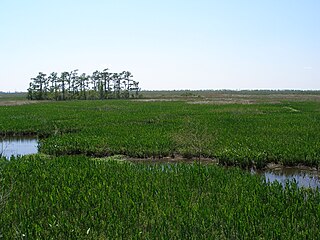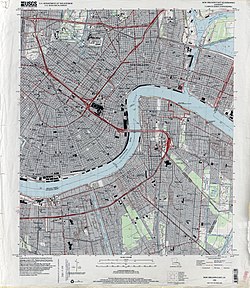
Jean Lafitte was a French pirate and privateer who operated in the Gulf of Mexico in the early 19th century. He and his older brother Pierre spelled their last name Laffite, but English language documents of the time used "Lafitte". This has become the common spelling in the United States, including places named after him.

The French Quarter, also known as the Vieux Carré, is the oldest neighborhood in the city of New Orleans. After New Orleans was founded in 1718 by Jean-Baptiste Le Moyne de Bienville, the city developed around the Vieux Carré, a central square. The district is more commonly called the French Quarter today, or simply "The Quarter", related to changes in the city with American immigration after the 1803 Louisiana Purchase. Most of the extant historic buildings were constructed either in the late 18th century, during the city's period of Spanish rule, or were built during the first half of the 19th century, after U.S. purchase and statehood.

Bourbon Street is a historic street in the heart of the French Quarter of New Orleans. Extending thirteen blocks from Canal Street to Esplanade Avenue, Bourbon Street is famous for its many bars and strip clubs.

The Strand Historic District, also known as the Strand District, in downtown Galveston, Texas (USA), is a National Historic Landmark District of mainly Victorian era buildings that now house restaurants, antique stores, and curio shops. The area is a major tourist attraction for the island city and also plays host to two very popular seasonal festivals. It is widely considered the island's shopping and entertainment center. The district includes properties along the south side of Harborside Drive and both sides of The Strand and Mechanic Street from 20th Street westward to 26th Street.

Jean Lafitte National Historical Park and Preserve protects the natural and cultural resources of Louisiana's Mississippi River Delta region. It is named after French pirate Jean Lafitte and consists of six separate sites and a park headquarters.

Dominique You or Youx was a privateer, soldier, and politician.

New Orleans Jazz National Historical Park is a U.S. National Historical Park in the Tremé neighborhood of New Orleans, near the French Quarter. It was created in 1994 to celebrate the origins and evolution of jazz.

Jackson Square is a historic park in the French Quarter of New Orleans, Louisiana. It was declared a National Historic Landmark in 1960, for its central role in the city's history, and as the site where in 1803 Louisiana was made United States territory pursuant to the Louisiana Purchase. In 2012 the American Planning Association designated Jackson Square as one of the Great Public Spaces in the United States.

The Presbytère is an architecturally important building in the French Quarter of New Orleans, Louisiana. It stands facing Jackson Square, adjacent to the St. Louis Cathedral. Built in 1813 as a matching structure for the Cabildo, which flanks the cathedral on the other side, it is one of the nation's best examples of formal colonial Spanish architecture. It was designated a National Historic Landmark in 1970, and is now a property of the Louisiana State Museum.
Pierre Lafitte (1770–1821) was a pirate in the Gulf of Mexico and smuggler in the early 19th century. He also ran a blacksmith shop in New Orleans, his legitimate business. Pierre was historically less well known than his younger brother, Jean Lafitte. While not as much of a sailor as Jean, Pierre was the public face of the Lafitte operation, and was known for his wit and charm, in addition to his handling of the sale of smuggled goods.

Madame John's Legacy is a historic house museum at 632 Dumaine Street in the French Quarter of New Orleans, Louisiana. Completed in 1788, it is one of the oldest houses in the French Quarter, and was built in the older French colonial style, rather than the more current Spanish colonial style of that time. It was declared a National Historic Landmark in 1970 for its architectural significance. The Louisiana State Museum owns the house and provides tours.

The Pontalba Buildings form two sides of Jackson Square in the French Quarter of New Orleans, Louisiana. They are matching red-brick, one-block-long, four‑story buildings built between 1849–1851 by the Baroness Micaela Almonester Pontalba. The ground floors house shops and restaurants; and the upper floors are apartments which, reputedly, are the oldest continuously-rented such apartments in the United States.

Ursuline Convent was a series of historic Ursuline convents in New Orleans, Louisiana. In 1727, at the request of Governor Étienne Perier, nuns from the Ursuline Convent of Rouen (Normandy) went to New Orleans to found a convent, run a hospital, and take care of educating young girls.
Vincenzo Gambi was a 19th-century Italian pirate. He was one of the most violent and bloodthirsty men in the Gulf of Mexico during the early 19th century and raided shipping in the gulf for well over a decade before his death. Gambi was one of several pirates associated with Jean Lafitte and later assisted him during the Battle of New Orleans along with Dominique You, Rene Beluche and another fellow Italian-born pirate Louis "Nez Coupé" Chighizola. He is briefly mentioned in the 2007 historical novel Strangely Wonderful: Tale of Count Balashazy by Karen Mercury.

This is a list of the National Register of Historic Places listings in Lafourche Parish, Louisiana.

Longfellow-Evangeline State Historic Site, located in St. Martinville, Louisiana, showcases the cultural significance of the Bayou Teche region. It is the oldest state park site in Louisiana, founded in 1934 as the Longfellow-Evangeline State Commemorative Area. Evangeline was Henry Wadsworth Longfellow's enormously popular 1847 epic poem about Acadian lovers, who are now figures in local history. In the town center, the Evangeline Oak is the legendary meeting place of the two lovers, Evangeline and Gabriel. A statue of Evangeline marks her supposed grave next to St. Martin of Tours Church. The state historic site commemorates the broader historical setting of the poem in the Acadian and Creole culture of this region of Louisiana.

Renato Beluche was an American-born Venezuelan merchant, pirate and privateer active in the early nineteenth century Gulf Coast. Born in New Orleans, Spanish Louisiana to a French smuggler, Beluche went to sea as a pilot's mate in 1802 onboard a Spanish Navy warship. By 1805, he had left the navy and become the master of a schooner. Using this ship, Renato turned to piracy and raided Spanish and British merchantmen operating in the gulf.

Cafe Lafitte in Exile is a bar in New Orleans' French Quarter that has operated continuously since 1933. It claims to be the oldest continuously operating gay bar in the United States.




















